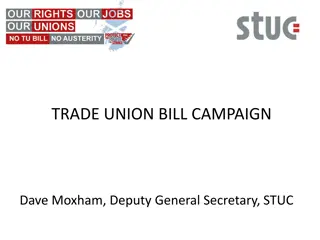Analysis of Alternative Solutions to the R59bn Special Appropriation Bill
In examining alternatives to the R59bn Special Appropriation Bill for Eskom, a proposition is made to utilize excess funds from the Government Employee Pension Fund and Unemployment Insurance Fund managed by PIC, rather than capitalizing Eskom from the National Budget. The consequences of continued financial support for Eskom from the budget are highlighted, along with the option of using available funds instead. The discussion also touches upon the 2019 Budget reductions and the stipulations for Eskom to access the additional financial support.
Uploaded on Oct 10, 2024 | 0 Views
Download Presentation

Please find below an Image/Link to download the presentation.
The content on the website is provided AS IS for your information and personal use only. It may not be sold, licensed, or shared on other websites without obtaining consent from the author.If you encounter any issues during the download, it is possible that the publisher has removed the file from their server.
You are allowed to download the files provided on this website for personal or commercial use, subject to the condition that they are used lawfully. All files are the property of their respective owners.
The content on the website is provided AS IS for your information and personal use only. It may not be sold, licensed, or shared on other websites without obtaining consent from the author.
E N D
Presentation Transcript
Alternatives to the R59bn Special Appropriation Bill Dick Forslund, dick@aidc.org.za
Proposition/Thesis in relation to the Special Appropriation Bill Don t use the National Budget to capitalise Eskom or rescue other SOE s. Use the excess funds of the state organs Government Employee Pension Fund (GEPF) and Unemployment Insurance Fund (UIF) managed by the over R2tr large PIC. All other discussions on Eskom s future and reforms are not dealt with here. For example: Establish a Eskom Reform Fund that takes over all debt (as proposed by Presidential Task Team on Eskom) Same answer: Do it or don t do it, but don t capitalise such an outfit from the National Budget. The R22bn remaining of the World Bank loan to Kusile and loans from Chinese Development Bank are also separate discussions.
Disposition 1. Consequences of continued financial support of Eskom and other indebted SOEs from the budget. - R23bn per year in the 2019 Budget. - The R59bn over 2 year in this Bill. - The order in the Technical Guidelines 2020 before the Mid Term Budget to cut spending by 5, 6 and 7 percent over three years. 2. The alternative of using available funds.
2019 Budget, p.48: Baseline spending reductions amount to R50.3 billion over the MTEF period. 54 per cent fall on compensation. Goods and services budgets for selected public entities will also be reduced by 1 per cent. ( ) specific programmes that have accumulated surpluses or require significant reform will be cut. Civil Society: Austerity! National Treasury: No! Still real growth in non-interest spending. Eskom: 23+23+23b=69bn
The Special Appropriation Bill (1)(a) An amount of R59 billion is hereby appropriated out of the National Revenue Fund for the requirements of the Department of Public Enterprises, of which 15 (i) R26 billion is for the 2019/2020 financial year; and (ii) R33 billion is for the 2020/2021 financial year. [The Nat Rev Fund: is a fund to which all taxes, fees and charges collected by the SARS and by departments must be paid ] As we also can read in the Bill: Conditions will be put to Eskom for accessing this extra R59bn support. A Chicken Race? Well, Eskom cannot be allowed to fail.
The Technical Guidelines 2020 order to Departments before the Mid Term Budget in October stipulated a 5, 6 and 7 % cut over three years
Not speaking of the present state in public services, like health and education and the social fabric falling apart: A 3.4% cut in non-interest spending will trigger a recession. Under the circumstances, the bias towards infra- structure spending promised in the Guidelines will rather increase such a push. The Treasury s order reads: A compulsory budget baseline reduction scenario of 5 per cent in 2020/21; 6 per cent in 2021/22 and 7 per cent in 2022/23 must be shown by institutions indicating where baseline reductions could be implemented with the least implications for service delivery. The economy is growing by less than one percent per year. There is low growth in the world economy and a threat of a global recession (Germany up next). Not the least because of the trade war between the US and China. Big corporations like Apple are heavily indebted. A new financial crisis might be on the cards, similar to 2007-2008 when a credit bubbles imploded. The 2019 Budget Review (page 22) as usual overestimated growth in its Baseline scenario , forecasting 1.5% growth. Growth presently at 0.9% year on year. If not already in November this year because of budget deficit reaching over 5%, counter to Treasury forecasts e t c beside unprecedented unemployment, a recession leads to a credit down grade to non-investment grade also by Moody s.
ALTERNATIVES TO HARSH AUSTERITY: Who are the main creditors of Eskom? Eskom s 2019 Report: The [Eskom] group is highly leveraged with total debt securities and borrowings of R440.6-Billion at 31 March 2019 and has to comply with certain financial and non-financial covenants. Short loans [ current ] : R53.4-Billion (due for pay-back this year). Long loans : R387-Billion The Note Related party balances and payments is crucial. Debt securities and borrowings: PUBLIC ENTITIES: R119.8-Billion 27% of Eskom s debt is owed to other state organs. 2019: About R95-Billion is owed to GEPF. (R87bn in March 2018). R9bn is owed by Eskom to the UIF (in March 2018). UIF has accumulated about R170bn to date. UIF runs a R8bn surplus per year. How is that possible? But let s turn to the R1.8-Trillion large GEPF (March 2018). N
In March 2018, the GEPF had lent R357bn to the Government (and R87bn to Eskom (over 20% of Eskom s debt). Investment income on the two loans can be estimated (!) to R25-Billion + R8-Billion = R33-Billion. R25bn was 13% of the government s debt service costs. R8bn is 30% of Eskom s financial costs 2018FY. The estimated R33Bn: 45% of GEPF s 2018FY investment income.
Keith Brainard was research director at the US National Association of State Retirement Administrators when he wrote (2010): [M] many pension plans remain underfunded for decades without causing fiscal stress for the plan sponsor or requiring benefits to be reduced. ( ) The critical factor in assessing the current and future health of a pension plan is whether or not funding its liabilities creates fiscal stress for the pension plan sponsor. ( ) A plan s funded status is simply a snapshot in a long-term, continuous financial and actuarial process, akin to a single frame of a movie that spans decades.
108.3% prefunding of liabilities. 90% is demanded in the GEP Law. 100% funding is the policy. The contingency reserves were added as a demand on the GEPF from 2006. There can be no counterpart in the SA economy for the R583.5- Billion that GEPF doesn t have. It is imali yomoya. In fact, we don t want the GEPF to have R583bn more in its funds!
The 33% increase in the actuarial audits demand for a solvency fund indicates too risky investments. Example: R202-Billion out of R1.034-Trillion is equity was invested in one company; Naspers. R577-Billion were placed in the more secure domestic bonds
Stop capitalising Eskom from the National Budget. Use the available resources . The state organ UIF s R170bn total surplus (where-of R154bn was held in an investment portfolio in 2018) should be a no-brainer to consider. The state organ GEPF : Shift asset allocations from shares in corporations to government bonds (adopting UIF s policy and handling the fact of a too small Solvency Fund). - Regulate the interest rate on inter-state lending to below 7%. - Apply a one year contribution holiday. Contributions are presently at R80bn; where of R51.5bn from the employer and R28.5bn from employees. - The employee contribution holiday will stimulate cramped domestic demand - Let GEPF take a hair-cut on it R95bn + interest claims on Eskom. - Magda Wierzycka s proposal of zero coupon bonds can be considered for loans that expires after 2030 (but the measure is to its nature a postponement of the debt costs) Such measures comprise no threat to pension payments. A shift from equity (company shares) to bonds will improve the GEPF s payment ability even more. The reason is the 3 percentage points higher cash investment income to GEPF from bonds compared to shares. The weighted average cash returns on GEPF s assets have been about 4.4% per year. Returns from shares have been around 3.4% on the assets held; from bonds over 7% on average.























